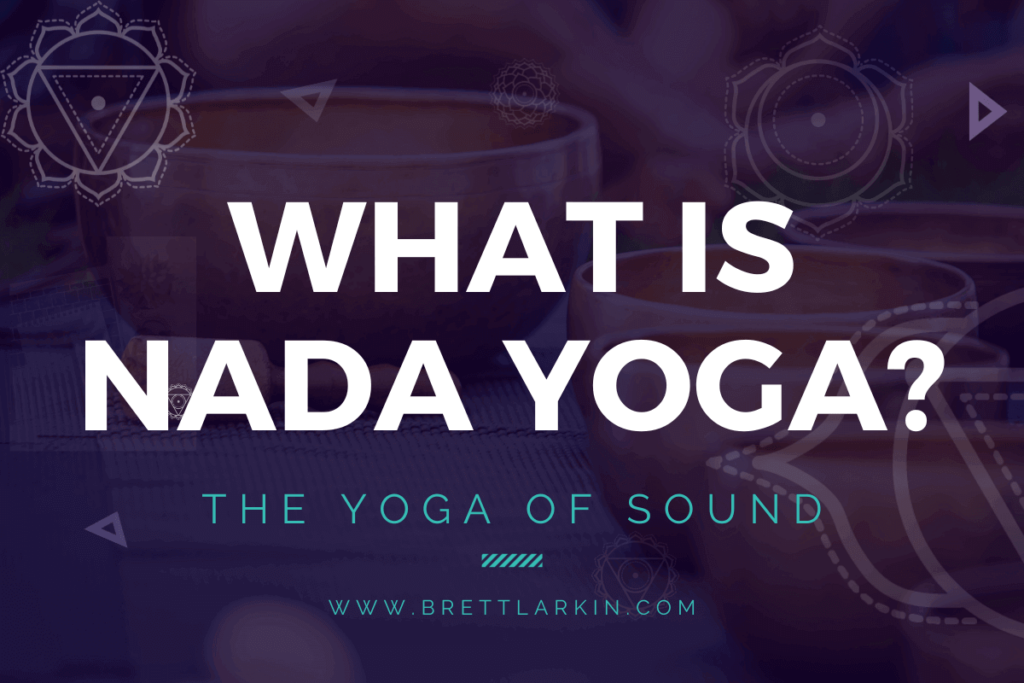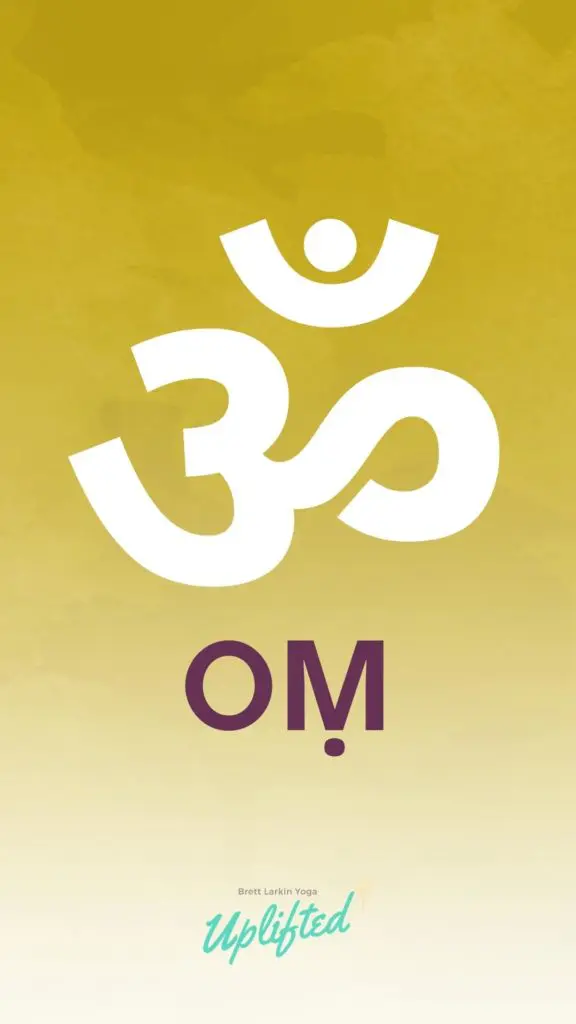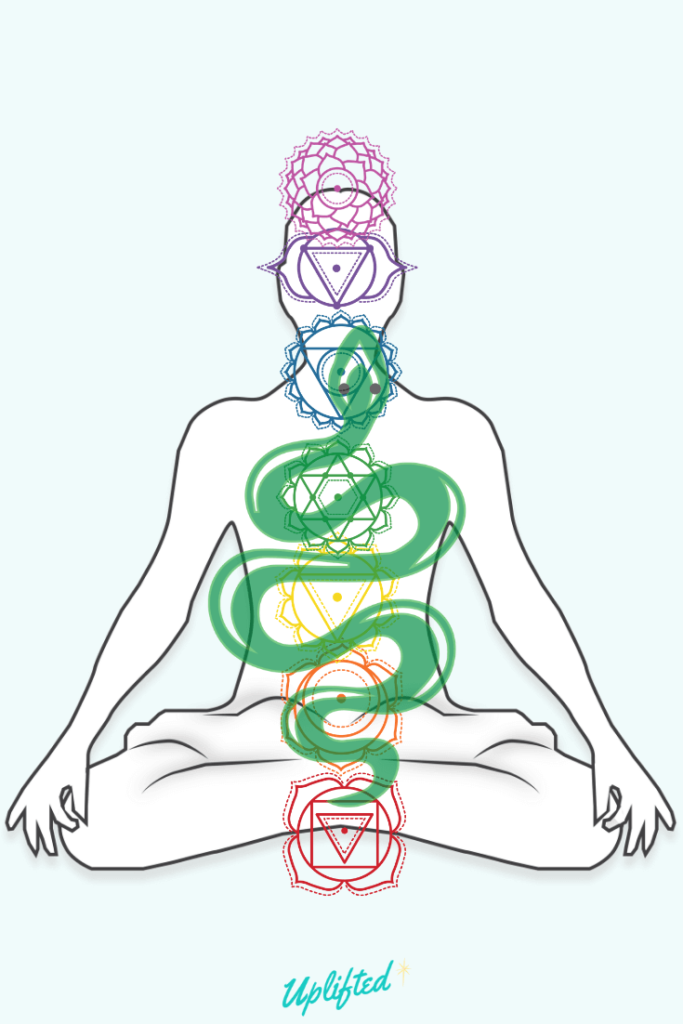Have you heard of Nada yoga? If you haven’t HEARD of it before – then you won’t understand my play on words here and that’s okay 🤪. Let me tell you all about it!
What Is Nada Yoga?
Nada is the Sanskrit word for the flow of pure sound or vibrations. It can be interpreted as the primordial sound vibration. The Sanskrit word Yoga means union. When these two words combine they invite union through sound vibrations.
The Hatha Yoga Pradipika describes Nada yoga as being one of the most fruitful meditation techniques known to calm the mind.
What is called nada yoga will differ for every teacher and practitioner, but the practice will always intentionally use sound vibrations to come into union with your true nature, Samadhi. It is basically the yoga of sound.
The Two Nadas of Nada Yoga
There are two classifications of sound when practicing nada yoga:
- Anahata Nada
- Ahata Nada
1. Anahata sound (Nada Brahman)
Anahata in Sanskrit means unstruck. Uplifted yogis will recognize the word as it is also the name of the fourth chakra (heart chakra).
Anahata nada refers to an unstruck sound. It is the sound you hear within yourself when you are able to be truly still and quiet. This is the inner sound or better said the vibrations of the self.
It could be said this sound is the great mystery because it is not always a sound necessarily perceived by the human ear. It is a sound that you sense within yourself and that connects you to consciousness.
2. Ahata Sound (shabda brahman)
Ahata refers to all external sounds. If it doesn’t come from within you, it is considered Ahata Nada. Music, nature sounds or another being’s vibrations are all types of the sacred sound of Ahata. Not sense sounds but sounds requiring the physical act of listening.
The Philosophical System of Nāda Yoga
In the ancient times before the Rig Veda (an ancient yogic text), people would sit in meditation and connect with cosmic consciousness. These people (Rishis) would see images and hear beautiful sounds. These sounds were called nāda. The Anahata nāda (inner sound) they experienced was recreated as Ahata nāda (external sound) and this is how Sanskrit became.
Since the Sanskrit language came from Anahata nada, it is a language meant to be sung. This is with the aim of making a sound resembling what the ancient yogis heard in their deep connection with the whole universe.
Nada yogi’s also believe that the five elements originated from Nada Brahman, the original sound. Isn’t that interesting to think about?!
The basis of the teachings of Nada yoga is that EVERYTHING that exists in the cosmos, consists of vibrations (Nada). So if everything is made of vibrations, Nada yoga is achieving union with the cosmos through sound.
Do you love learning about the deep history of yoga? Me too! Nerd out with me on the journey yoga has taken to be the modern practice you know today!
What Is Yoga Sound?
Now that you understand the Vedic philosophy that vibrations are everything in the cosmos, what are the types of sounds that can be used to achieve the desired union? In this section, I will lead you through all the different types of sounds that can be used in your yoga practice so you can become a nada yogi.
There are 3 basic sounds you can make even if you do not have a tongue; “aaaaa” “ouuuu” and “mmmmmm”. All other sounds require tongue movement. Combined together these sounds create “AUM” better known as “Om”.
“Om” is considered to be the most sacred sound. When you make this specific sound you can feel the vibration in your whole body.
There are 4 different stages of Nada sound.
- Vaihari (the audible sound)
- Madhyama (the mental sound)
- Pashyanta (the subconscious sound)
- Parananda (the transcendent sound)
Each stage of sound will affect your body and any psychological conditions in unique ways. Try them all, and find what works best for you.
My Favorite Sounds
Chanting
I believe in chanting so much that it is the first topic discussed in my 200-hour Yoga teacher training. Chanting with your own voice is an Anahata nada, an internal sound. It belongs to various traditions because your own voice is uniquely beneficial to you.
If everything, including you, is made of vibrations. When you use your voice to create new vibrations they are uniquely healing to your own existing vibrations. Chanting will create a longer exhale breath which will bring about calm and increase your sense of well-being.
This is one when you chant with your own voice it will be more beneficial to you than if you are listening to others chanting. A teacher chanting for the whole class will also be beneficial to your being but it doesn’t affect your body or consciousness in quite the same way as your own vocal vibrations.
A deep breath is always best to start a chant. If you’d like to hear me chanting one of my favorite practices- and I’m totally thrilled I got to record this original audio btw 🎉 – check out my Spotify.
Chanting a traditional mantra will connect you deeper with the Sanskrit language. The word mantra comes from Sanskrit and they are most often repeated during meditation as part of old spiritual traditions. More on the mantras involved in Chakra work coming up!
Music
Musical sounds are one of the easiest ways to practice nada yoga. You have probably already done yoga with music, so you’re already practicing nada yoga – look at you superstar 🤩!
Just like with yoga practice and mantras, the intention behind your actions is what matters. When you select your choice of music for the next practice, remember the nada yoga philosophy. Do the vibrations you are feeling from your choice of music align with the intention of your practice?
Any music that suits your fancy will fall into the Ahata nada category.
What you decide to play matters and listening to classical Indian music, for example, is one way to connect with the rich history of the practice you are participating in. It is important to make efforts to support the culture of yoga’s origins!
Instrumental music is generally preferred to lyrical if you are working on connecting to higher consciousness. Although some Indian classical music includes mantras in Sanskrit.
That said, you may not connect to these traditional tracks. Listen to what resonates with you. If you feel tuning into Sanskrit could bring you closer to the entire cosmos go for it! If Taylor Swift speaks to the very depths of your soul and brings you into a place of harmony then by all means throw on Lavender Haze. It is yogi’s choice!
Nature Sounds
Natural sounds from being outside or from a video are a great way to connect to the whole universe. Rishima Bahadoorsigh discusses in depth the traditions of Nada yoga including Raga (the combination of specific notes from the frequencies of nature to create a melody). It is said that Raga originated from listening to nature sounds.
You can use the Raga videos you find to allow the kundalini serpent to climb up the chakra with these specific notes of music. How amazing!
Now you know all about the importance of vibrations and sound – let’s talk about all the ways to incorporate sound into your existing yoga practice.
Nada Yoga Techniques
You are ready to start practicing the yoga of sound, but wondering where to start. Right here!
1. Add Sound To Your Existing Yoga Practice
If you’ve read this far you likely have a strong passion for yoga. Whether you do 108 surya namaskars or you sit still in meditation for hours, your practice is your own and you can make that same practice nada yoga by simply adding a soundtrack.
I listed my favorite yoga playlists on Spotify to get you started. If you’re a yoga teacher, then read my guide on how to get music for your yoga classes.
If you are using external music in your nada yoga practice, remember that other sounds will interfere with any internal or subconscious sound that comes from your inner self. Make sure you allow some silent time in your practice to listen to the sound of the whole world that surrounds you and allow it to channel through you.
2. Nada Meditation
Speaking of silence, you can participate in a Nada meditation. You may want to use a Raga for the time of day that you are practicing. On the other hand, you may want to test your nada yogi skills to see what sounds you can hear coming from within.
This is what I love about practicing the yoga of sound, there are so many ways to do it!
3. Create a Nada Yoga Sadhana
Sadhana can be defined as a daily spiritual practice. This could be as simple as chanting Om before bed, or you could use the Kundalini tune in every morning to connect with your vibrations.
The way to make these simple practices yoga is the intention behind them. Know when you begin your chant that you are connecting to the cosmic consciousness through your ever-humming vibrations.
4. Connect with the Chakras through sound
Each chakra has a sound meant to activate it, called bija mantras. Focus on one chakra for a day or do them all in the same practice to stimulate the whole body.
Connecting to the chakras with Nada yoga will give you a greater sense of connection to your body. The better you can listen to what is going on in your body, the better your union with yourself, those around you and Divine consciousness will be. Yoga means union after all!
Closing Thoughts
According to the Vedic texts this practice of Nada yoga, the yoga of sound, can be your most powerful tool for a balanced life. Human beings vibrate just as the cosmic consciousness vibrates. Spiritual traditions teach us that we can use these vibrations for inner transformation and self-realization.
Not only this, but modern science is starting to catch up to what the ancient yogis already knew. That every cell in your body, everything that makes you a human being, vibrates to a specific frequency and sound can travel through the body quickly to match those frequencies and promote healing(read more on how in this fascinating article). This is why your voice is the most powerful healer for your body, because it is designed to match the frequencies of YOUR body.
Nada yoga asks us to listen. Listen to what is happening around you, listen and sense what is happening WITHIN you as well. Nada yoga asks you to use those ear muscles to deepen your practice, your spiritual connection and bring yourself closer to homeostasis.
My hope is that on your next deep yogi breath, you’ve harnessed the ability to listen for the sounds of the body, mind, and soul practicing nada yoga.
Next Steps
- If you’re interested in practical kriya yoga as a way to improve your daily life and relationships, check out my Yoga for Self Mastery course.
- Order my Yoga Life book for a practical guide to creating balance in your life through yoga.
- Check out my YouTube channel and find some yoga classes that you can try out for yourself!
FREE Chakra Balancing Audio Track + Journaling Prompts

YOU MIGHT ALSO LIKE
- What is Kriya Yoga? The Philosophy and Practice
- Uddiyana Bandha: Tapping Into Your Deep Core
- 4 Reasons Hasta Bandha Is Essential To Your Yoga Practice
- Vitarka Mudra: What It Is and How Do You Use It?
- Shakti Mudra: What It Is and How Do You Do It?
- Garuda Mudra: What It Is and How Do You Use It?
- Kali Mudra: What It Is and How Do You Do It?
- Shunya Mudra: What It Is and How Do You Do It?
- Varuna Mudra: What It Is and How Do You Use It?
- Vayu Mudra: What It Is and How Do You Use It?
- Samana Vayu: The Energy of Balance & How to Access It
- Apana Vayu: The Energy of Release & Surrender
- Udana Vayu: The Ascending Wind
- Prana Vayu: The Breath of Vitality
- Vyana Vayu: The Energetic Secret to Flow
Learn how to do 11 of the most popular yoga poses correctly. Free video + PDF download.















